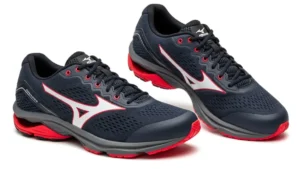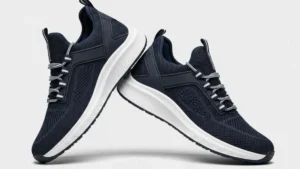
Introduction
Running with a headband helps keep sweat out of your eyes, prevents hair from becoming a distraction, and allows you to stay focused on your stride. It’s a simple piece of gear that makes runs more comfortable and keeps your attention where it should be—on performance, not irritation.
Most runners face two common problems: sweat dripping into their eyes and hair moving across their face. Both pull attention away from running form and breathing. A headband solves these issues by absorbing sweat and holding hair in place.
Think of it as a windshield wiper for your forehead. The sweat gets caught before it stings your eyes. Instead of constantly wiping your face mid-run, you stay locked in on pace and rhythm.
Why Do Runners Wear Headbands?
Runners wear headbands to manage sweat, improve comfort, and maintain concentration. A headband stops sweat from dripping into the eyes, keeps hair from interfering with vision, and gives runners a steady sense of control. All three benefits add up to smoother, more focused performance on the road or track.
Headbands and Sweat Management
Sweat can sting the eyes, blur vision, and make a run feel harder than it should. The constant need to wipe sweat breaks rhythm and wastes energy. A headband acts like a barrier, absorbing moisture before it becomes a problem.
Preventing Distractions During Runs
Loose hair sticking to the forehead or sweat dripping across the face breaks concentration. Imagine pushing through mile six and being forced to swipe sweat every few seconds. A headband holds everything in place, so the only thing on your mind is your pace.
Confidence and Mental Focus
Gear plays a role in mindset. Just as lacing up the right shoes signals it’s time to run, putting on a headband can give a mental boost. It creates a “ready” feeling that translates into sharper focus once the run begins.
Comfort Benefits of Running with a Headband
Keeping Sweat Away from Eyes
Sweat running into the eyes causes irritation, burning, and blurred vision, which interrupts a runner’s focus. Studies show that nearly 65% of runners report eye irritation from sweat during training or races. A headband absorbs moisture before it reaches the eyes, keeping vision clear and runs more comfortable.
A headband works like a shield across the forehead. Instead of stinging sweat dripping down mid-run, it traps the moisture in the fabric. This small barrier means fewer stops, less wiping, and more consistent running rhythm.
Temperature Control and Breathability
Headbands regulate temperature by pulling sweat away from the skin and allowing airflow. Summer headbands keep the head cooler with lightweight moisture-wicking fabric, while winter thermal headbands hold warmth while still allowing the skin to breathe.
In hot weather, sweat-wicking materials like polyester blends pull moisture outward where it evaporates. In colder months, fleece-lined headbands keep ears and forehead warm without trapping excess sweat. Having the right type for the season makes every run more manageable.
Lightweight Gear That Feels Natural
The best headbands are so light that runners barely notice they’re wearing one. Lightweight design matters most during long runs where every ounce of gear adds up. Comfort comes from fabric that feels natural against the skin and doesn’t shift while running.
Think of it like running shoes—if they’re distracting, they’re the wrong choice. A good headband should disappear once it’s on. Many runners describe it as the “forgot I had it on” effect, which is exactly what you want for comfort on the road.
Focus Benefits of Running with a Headband
Reduced Distraction for Mental Clarity
Keeping hair and sweat under control means fewer interruptions and sharper focus. During endurance runs, even small distractions like wiping sweat can break concentration. A headband removes these issues, letting runners lock in on pace, breathing, and distance instead of constant adjustments.
When the mind isn’t split between discomfort and performance, focus lasts longer. This steady concentration is what helps runners maintain form and mental strength through long miles.
Consistency and Routine
Wearing a headband becomes part of a runner’s ritual, adding predictability and comfort before every run. Small habits like this build mental readiness and reduce anxiety. Over time, the simple act of putting on a headband can signal the body that it’s time to run.
Runners often share how routine builds discipline. One distance runner put it plainly: “My shoes and my headband go on together. Without them, it feels like something’s missing.” These small rituals anchor focus before the first step.
Psychological Edge in Races
Gear influences mindset, and headbands are no exception. Just like race-day shoes or a favorite running watch, a headband can serve as a mental cue for readiness. Feeling prepared boosts confidence, which often translates into better focus during competition.
Think of it as armor before battle. While the shoes carry the body and the watch tracks performance, the headband steadies the mind. Knowing you won’t fight sweat or hair mid-race gives a quiet psychological advantage.
Different Types of Running Headbands
Sweat-Wicking Headbands
Sweat-wicking headbands are best for hot climates and long-distance runs because they draw moisture away from the skin, keeping runners cool and comfortable. They dry quickly, prevent sweat buildup, and are designed to handle long sessions where overheating and constant wiping would otherwise break focus.
Most are made from polyester or microfiber blends that feel soft while moving sweat outward for evaporation. Marathon runners often favor these headbands since they provide comfort mile after mile without becoming heavy or soaked.
Thermal Headbands
Thermal headbands are designed for cold weather, offering warmth and wind protection while still allowing skin to breathe. They’re typically fleece-lined or wool-blend, making them ideal for winter training or races in chilly climates.
They cover the ears and forehead, blocking wind chill without trapping sweat against the skin. A thermal headband gives comfort similar to a lightweight beanie but with better breathability and less bulk, which makes it perfect for winter runs.
Fashion and Style Headbands
Fashion-focused headbands strike a balance between function and appearance. They’re built to manage sweat and hair but come in colors, patterns, and styles that runners can match with gear or personal taste. While performance is always the priority, many runners enjoy having a stylish option for casual jogs, gym workouts, or group runs. Some brands even design multipurpose headbands that transition from workouts to everyday wear.
Choosing the Right Running Headband
Material Matters
The fabric of your headband makes all the difference in comfort and performance. Cotton feels soft but traps sweat, making it heavy during long runs. Polyester and spandex blends are better at wicking away moisture, staying light, and keeping you cool. Breathable mesh options also add airflow, which can be a game-changer for runners in warm climates.
Fit and Adjustability
A good headband should feel snug without causing pressure. If it’s too tight, you risk headaches; too loose, and it will slip mid-run. Many modern headbands include silicone grips, stretch fabrics, or Velcro straps that allow for easy adjustment, ensuring a secure fit for different head sizes and hair types.
Washing and Durability
Sweat and buildup mean running headbands need regular washing. Ideally, wash them after every two to three uses to maintain hygiene. High-quality headbands typically last six months to a year, depending on frequency of use and care. Machine-washable and quick-dry designs extend durability while keeping maintenance simple.
Common Mistakes When Running with a Headband
Choosing the Wrong Size
Size matters more than many runners realize. A headband that’s too tight can cause pressure headaches and leave uncomfortable marks, while one that’s too loose will constantly slip, breaking your focus. The ideal fit is snug enough to stay in place during movement but never restrictive.
Ignoring Material Quality
Not all headbands are built the same. Cheap cotton ones tend to absorb sweat and become heavy instead of pulling moisture away. High-quality polyester or spandex blends are designed to wick sweat and dry quickly, ensuring you stay comfortable even on long runs. Skipping material quality often means trading performance for short-term savings.
Overusing Without Washing
Wearing the same headband multiple times without washing is a fast track to hygiene issues. Sweat, oils, and bacteria build up quickly on fabric. Studies show that bacteria on unwashed workout gear can double within 24 hours, leading to odors and potential skin irritation. Washing your headband every few uses helps keep it fresh and safe.
Tips for Getting the Most Out of Running with a Headband
Test Different Styles
Not every headband works the same for every runner. Some prefer wider bands for maximum sweat absorption, while others like slim, lightweight options for minimal feel. Testing a few styles helps you find what fits your comfort, performance, and personal running needs.
Match Weather Conditions
Weather plays a huge role in choosing the right headband. In hot climates, sweat-wicking headbands keep moisture under control and help you stay cool. In cold or windy conditions, thermal headbands add insulation and protect your ears. Picking the right type ensures year-round performance.
Make It Part of Routine
Consistency builds comfort and confidence. Wearing a headband regularly makes it part of your pre-run ritual, just like lacing shoes or setting a watch. Over time, this routine not only improves physical comfort but also reinforces mental focus before each run.
Final Thoughts
Running with a headband is more than a style choice—it’s a practical tool that enhances comfort and focus. By managing sweat, keeping hair in place, and adding a layer of mental confidence, headbands help runners stay consistent and distraction-free. For a stronger visual impact, a short video showing runners training with headbands could inspire readers to see the benefits in action.
FAQs
Do headbands really help runners?
Yes. Running headbands help control sweat, keep hair out of the face, and improve focus. They’re especially useful during longer runs when distractions from sweat or slipping hair can affect performance.
Can I wear a headband in winter?
Absolutely. Thermal headbands are designed for cold-weather runs. They cover the ears, block wind, and retain warmth without trapping excess heat, making them a great alternative to bulky hats.
Are running headbands better than hats?
It depends on the situation. Headbands are lighter, breathable, and better for sweat management, while hats provide fuller coverage for sun or rain protection. Many runners use both depending on weather conditions.
How do I wash my running headband?
Most headbands can be machine-washed on a gentle cycle with mild detergent. Avoid fabric softeners, as they reduce sweat-wicking ability. Air drying helps maintain elasticity and durability.
Can a headband replace sweatbands?
Yes, in most cases. A good running headband is designed to wick away sweat just like a wrist sweatband but with the added benefit of keeping sweat from dripping into your eyes while also managing hair.




